Z77 mITX Round-Up: Five of the Best – MSI, Zotac, ASRock, EVGA and ASUS
by Ian Cutress on December 31, 2012 7:00 AM EST- Posted in
- Motherboards
- MSI
- ASRock
- EVGA
- ZOTAC
- Asus
- Ivy Bridge
- Z77
- mITX
ASRock Z77E-ITX BIOS
As already mentioned in the overview to the Z77E-ITX, its BIOS is a step back from the most recent implementations of the BIOS we have seen on the X79 Extreme11 and FM2A85X Extreme6 – instead of that starry background we get the older blue on white indicative of the earlier Z77 products. This is mostly likely due to the mid-2012 release of this motherboard, but going through the history of the ASRock BIOS, there is an evolution taking place:
ASRock H67M-GE/HT
ASRock Z77E-ITX
ASRock X79 Extreme11
Despite the evolution, ASRock have kept the general design constant. This means information like the motherboard model, BIOS version, processor installed, processor speed, memory installed and memory speed are right there on the front menu – useful for anyone wanting this information without loading an OS or opening up the case. All that is missing is perhaps the CPU temperature and CPU fan speeds. If this was all wrapped up in an aesthetic and interactive scenario we would be on to a winner.
With the Z77E-ITX BIOS, the Main screen has access to two functions – the System Browser and the Online Management Guard.
The System Browser shows the motherboard with all the changeable ports highlighted. By rolling the mouse over each of them, it will tell the user what it detects in that port. Thus if a SATA device suddenly stops working, users can check this to make sure the BIOS still recognizes it.
The Online Management Guard is an interesting way to get around the ‘how to keep the kids off the internet when they should be doing schoolwork’ issue – users can select hours of the day at which the network controller will be disabled. Unfortunately the system is easily disabled by going back into the BIOS and either changing the BIOS clock or changing the OMG setup itself. Yes, OMG is an odd name for this feature – “OMG, it’s so easy to disable!”
The main bulk of the options are found in the OC Tweaker menu:
The OC Tweaker menu is arranged into lists of features relating to separate parts of the system. First is the CPU configuration, relating to CPU ratio, BCLK and power limitations. We also have overclocking support for the integrated graphics. Underneath this is the DRAM timing options, which give XMP support or a manual adjustment of the timing ratios. The voltages are further down, and we are given Load Line Calibration options as well with diagrams to show how LLC varies with ‘Level’. Finally there are options to save the current settings for future usage.
The Advanced menu deals with the non-overclocking options: we have access to our SATA/USB configurations, as well as the extra controllers on board and the NB/SB options. In order to flash the BIOS via USB or the Internet, the options are in this menu.
The fan settings are found in the H/W Monitor option along the top, and in keeping with previous ASRock motherboards, the fans are set to 100% by default. This is by no means the best way of presenting the motherboard out of the box, resulting in high noise levels unless the options are changed. The fan options on the Z77E-ITX allow for both fans to have a ‘maximum’ temperature after which the fans are on full, and a target fan speed which sets the fans to that speed below the target temperature.
Elsewhere in the BIOS are boot options and security options. Annoyingly missing is a boot override function, useful for those one-off USB installation scenarios.


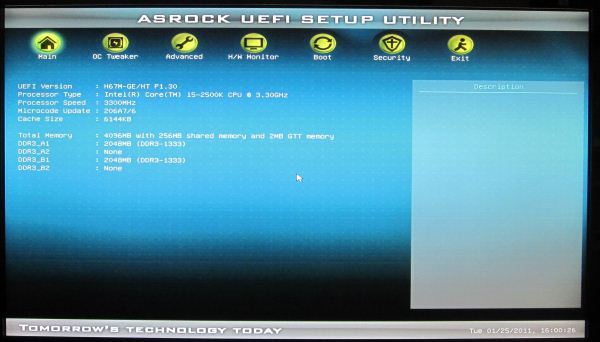

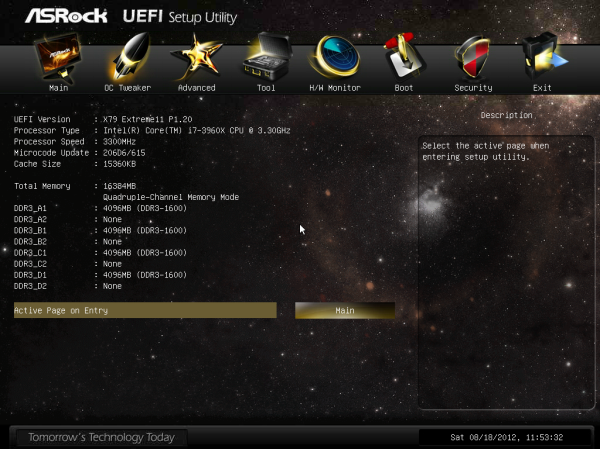
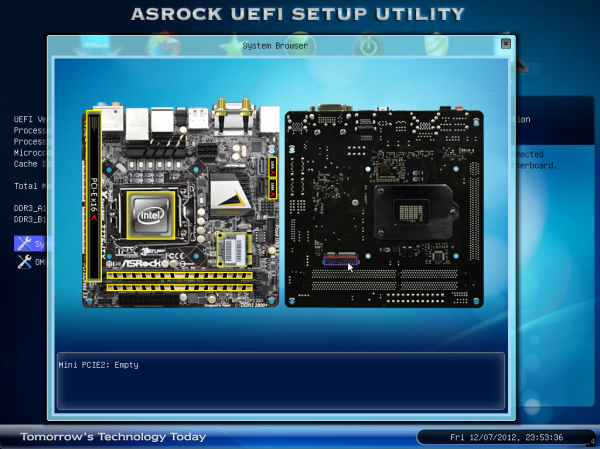

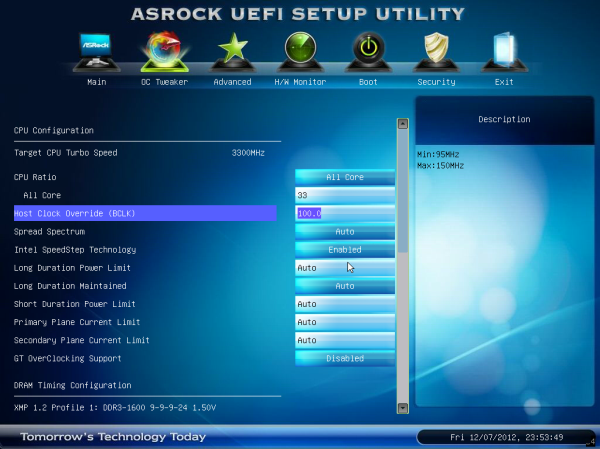
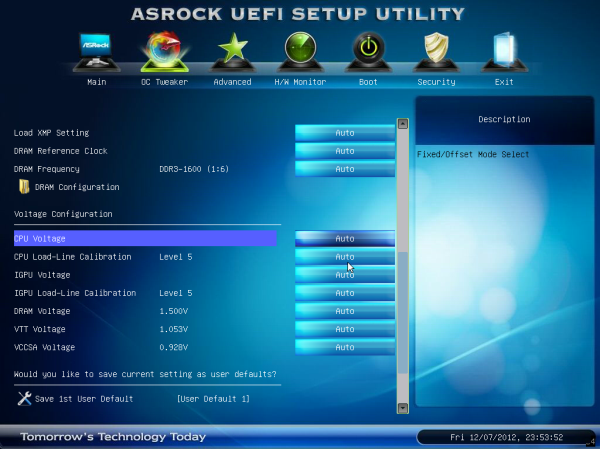
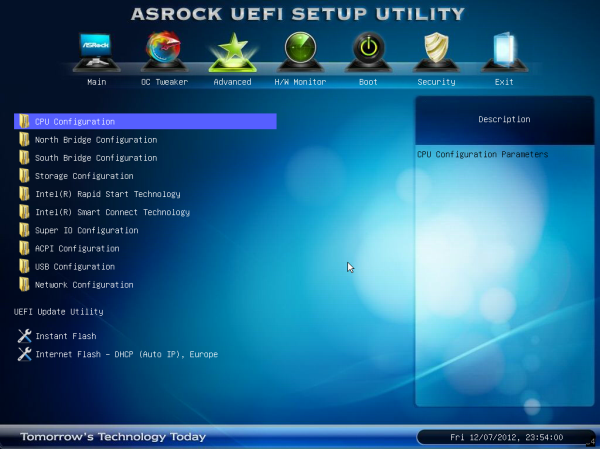
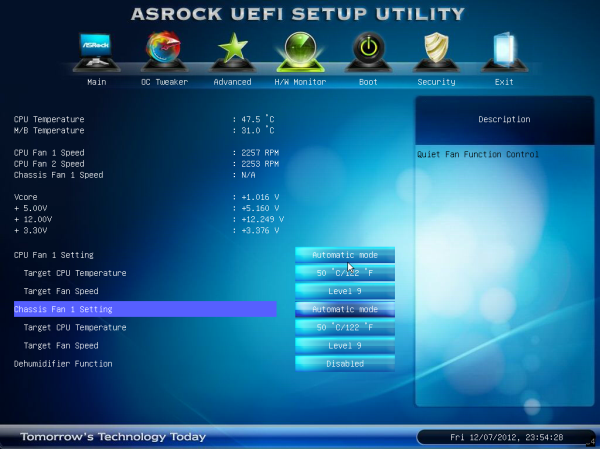














54 Comments
View All Comments
Sabresiberian - Tuesday, January 1, 2013 - link
Thanks for the great comparison review!It looks like there is a little mistake in the spec list for the Asus board, which shows it having a mini-PCIe connector. I would love it if it did, but I didn't see it on the board and it isn't mentioned in other spec lists.
It is important to me because I would ideally need connection for both a graphics card and a sound card (which I believe I could do through a mini-PCIe to PCIe x1 adapter if needed). This makes the EVGA Stinger the choice for me here, though the Asus board is the one I would prefer to buy.
I am truthfully a little disappointed in the EVGA board, which seems all too common with EVGA products in general these days. Great support is still there, but I'd rather they build bleeding edge components and not have to find out whether or not their support is as good as people say it is. The Stinger is a good board to be sure, and the Intel LAN alone puts it in the category of "will buy" for me, but I was hoping it would be something that would match or beat the Asus P877-I, and it just doesn't.
Foeketijn - Tuesday, January 1, 2013 - link
When you take overclocking out of the equation, B75 has it all, for the price just a tiny bit north of the old H61 chipset. Support for IB features (1600Mhz DDR3, PCI-e 3.0), Native Sata III, USB 3.0.It wasn't intended for the DIY market but fits the bill perfectly in my opinion. Only the very very few who need to OC, +16Gb ram or multiple SSD's @ full 6 Gb/s need the Z77 chipset.
The only thing is, that us mere mortals can't predict is, if a much cheaper chipset is used, did the OEM also cheapskate on the critical parts to? I would love to see some in-depth component analysis which I see for example, when a PSU is taken apart.
Which components are used? how well is the soldering done, does it still work at a sauna lanparty, etc.
I might be alone in this, but I would find that much more valuable information than all the performance benchmarks together (race to the bottom, be dammed!).
Including the northbridge in the CPU made motherboard and CPU reviews so predictible (or borring).Since then, I'm only interested in stability, ease of installation (nicely covered) and practical use (fan controll, MEM compatibility ect).
<offtopic> Oh I loved the XP-m 2500+ siverpainting 2001 era where you actually could get a noticeable improvement of performance and not necessarily have to sacrifice stability or risk bankruptcy</offtopic>
vanwazltoff - Tuesday, January 1, 2013 - link
i picked up an asus p8z77-i deluxe/wd before christmas and made a beast gaming computer out of it with an i5-3750k OCed to 4.5ghz and a gtx670 =]vanwazltoff - Tuesday, January 1, 2013 - link
*3570kBeaver M. - Tuesday, January 1, 2013 - link
Loved the POST screen measurements and the DPC latency testing. Something you dont see every day. Actually Ive never seen it, and yet I always wanted to know those.However I am not really interested in the Z77s, since they have a horrible layout for my needs. Only the Asus one comes close to what I need, but I just dont buy Asus anymore because of several very bas experiences.
So, I wish you would also test the B75 and H77s.
paksoy - Tuesday, January 1, 2013 - link
I love the features of this Asus mobo, but i want to use it in a really small form factor case like the Antec ISK 110 VESA Case.http://www.anandtech.com/show/6192/antec-isk-110-v...
I'm just worried that the height of the VRAM board would prevent it from using it with this case.
mi1stormilst - Tuesday, January 1, 2013 - link
I still opted for the Gigabyte Z77N and love it...Sivar - Wednesday, January 2, 2013 - link
Does this refer to the ALC889 playing an audio file encoded at 192KHz?If so, does it really matter? Failing a test is never a good thing, but I know of no widely available 192KHz audio source, and such a source would have no benefit, nor would a 96KHz source.
cjs150 - Wednesday, January 2, 2013 - link
I am a happy user of the AS Rock board in a silent HTPC. It works exceptionally well. However it is clear that some work still needs to be done on motherboard design.MSata on back is excellent - now can we have it as SATA 3 because the better MSata SSDs are all Sata 3.
Placement of Sata connectors is often awkward on these boards. On edge and at right angles please.
Similarly I would love it if someone either did the 24 pin ATX power connector at right angles or someone manufactured a right angled converter that did not require de soldering the motherboard connector. Cable management in Mini-OTX is very hard and that would really help.
Finally, careful choice of RAM can eliminate issues Ian had about the closeness of the CPU socket preventing the use of many after market coolers. I use the Samsung green low profie memory, which is so low that any after market cooler can be used (and runs at 1.35v, is an unbelievably good overclocker and reasonably priced!)
romrunning - Wednesday, January 2, 2013 - link
As has been mentioned previously, the H77 chipset is great for those who do not need overclocking. I've used the Intel DH77DF, and I heartily recommend it. Since the DH77DF has an eSATA port (not too common), I've even been able to keep an eSATA dock that I used before USB 3.0 was more readily available. If you install this board into a Fractal Design Node 304 case, you can use all of the SATA ports as well. I've used it with a Silverstone SG05 case, and the loudest part of my setup is the fan on the graphics card (Radeon 7850).One thing I've noticed, though, is the relatively low mic input from the front audio. Not sure if this is common to the Realtek ALC8xx chip series, but even after boosting the gain in Win7 to +30db, it still isn't quite as loud as an older AMD board I previously had (which didn't need a boost at all).